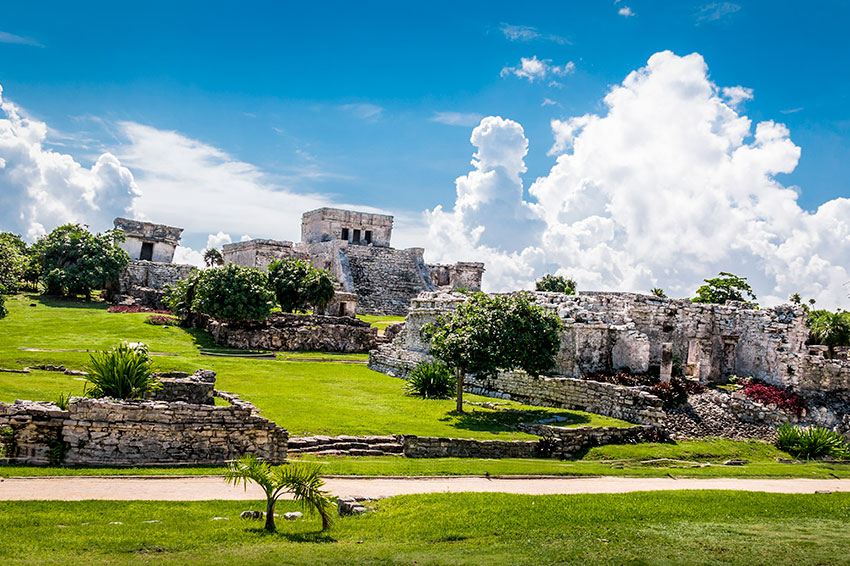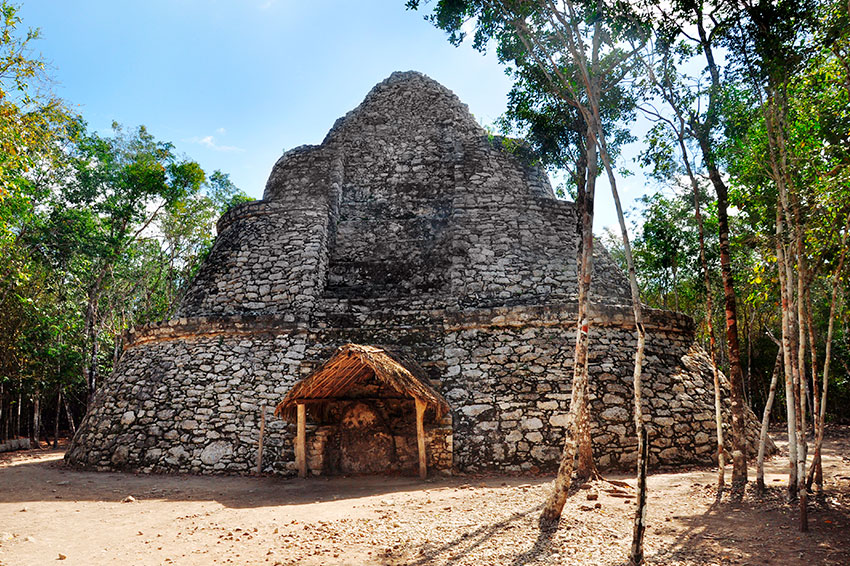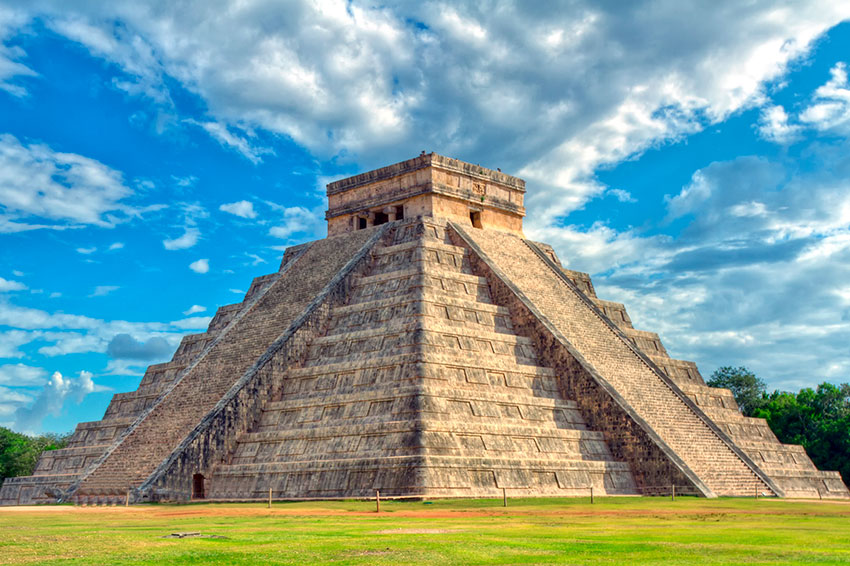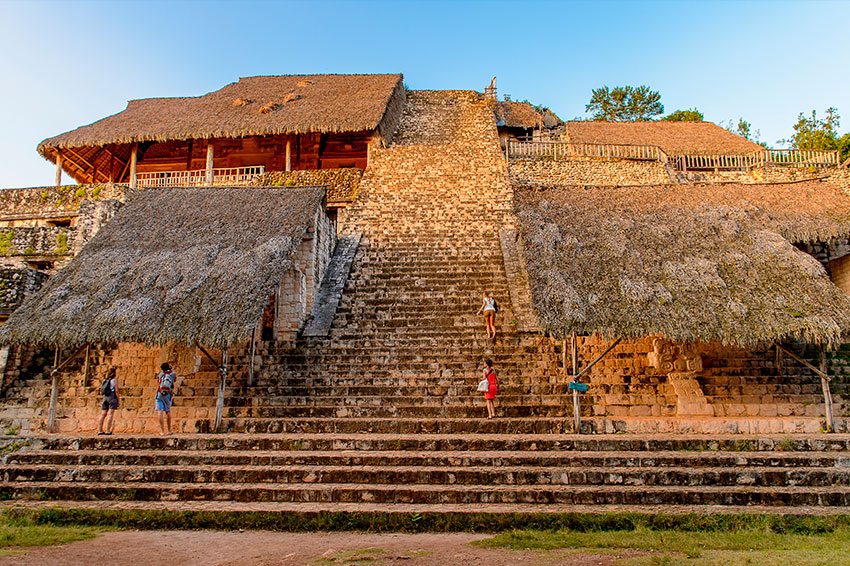After months of closure due to the COVID-19 pandemic, archaeological sites in Quintana Roo and Yucatán are open. With their ancient grandeur, air of mystery and jungle settings rich in nature, we think that a visit to the Yucatan’s archaeological sites is a must on your next vacation. Explore palaces and temples and marvel at the skill of long-lost artists. Take a deep breath of fresh air, close your eyes and listen to the sounds of the wind in the trees and birdsong. Here is a quick guide to some of the major sites to get you started.

Tulum
With its stunning cliff top location overlooking the Caribbean and a small bay at the foot of the rocks, Tulum is worth the visit just for the view!
“Tulum” means “wall” in Maya, a reference to the sturdy stone barrier that protects it on three sides, the fourth being the sea, but in ancient times the city was known as Zama or Dawn. An inscription on a stela or standing stone found at the site reveals that it was inhabited as far back as A.D. 564 although it reached its peak during the Post-Classic period (1250–1521) as a port on the sea and land trade routes.
The El Castillo temple dominates the site; other important groupings are the Temple of the Descending God, Temple of the Frescos, the House of the Columns and the Temple of the Wind.
Watch iguanas basking in the sun on stone platforms and hummingbirds sipping nectar from orange ciricote blossoms. As you walk back along the nature trail through the mangroves you may spot families of coatimundis, flocks of Yucatan jays and even a boa coiled in the undergowth.

Coba
From Tulum on the Riviera Maya coast, head inland to the ancient city of Coba (25 miles/41 km from the coast), one of the Maya World’s largest archaeological sites.
Coba means “waters ruffled by the wind” in Maya and the pyramids and temples at this jungle site are clustered around a chain of shallow lakes. The city reached its peak during the Mayan Classic period, A.D. 250-900, when it was an important trade center. Archaeologists believe that it may have had links with Tikal in Guatemala. The most recent discovery at the site is the identification of the ancient dynasty that dominated Coba and the names of some of the 14 rulers through the study of hieroglyphic inscriptions carved on stelae and wall tablets.
The principal buildings at Coba is Nohoch Mul, at 42 meters, the tallest pyramid in the northern Yucatán. The views from the top are amazing if you have a head for heights. Other important clusters of buildings are the Cobá group, La Iglesia (another pyramid), Las Pinturas, the Ball Court, Xaibe and the Macanxoc group which has nine circular altars and eight stelae.
Cobá is also famous for the sacbes or Mayan causeways that radiate from the heart of the city. The longest sacbe in the Maya World links the city with the site of Yaxuná, near Chichén Itzá and is 101 km long.
One of the thrills of exploring Coba is being in the jungle and catching a glimpse of some of the creatures that make their home among the trees. Towering chicozapote trees, tropical figs, chacas and ceibas compete for space, their branches festooned with lianas, orchids and bromeliads. Huge blue morph butterflies flit through jungle clearings. Look up and you may spot spider monkeys, flocks of parrots, toucans and a flash of turquoise and russet as a motmot bird takes flight.

Chichen Itza
Two and a half hours from Cancun, the ancient capital of the Itzae Maya, Chichén Itzá is the most famous archaeological site in the Yucatán and a UNESCO World Heritage Site. Once a major power in the Maya World, it was a sacred center where rulers and astronomers watched the heavens for portents. A masterpiece of architecture and art, the city still has an aura of power and mystery.
Archaeologists have found fragments of pottery in Chichén Itzá indicating that there was a settlement at the site as far back as 300 B.C., although it wasn’t until the Classic period that the first stone temples and palaces were built between A.D. 500 and 750 and the city began to expand. At the height of its glory A.D. 800-1150, Chichén Itzá controlled the Yucatán politically, commercially and militarily. Its power began to wane around 1150 and by 1250 the city had been abandoned.
The city is vast and archaeologists are still excavating temples in the forest, particularly in the area known as Chichen Viejo or Old Chichen. The art and architecture at Chichen Itza is a mix of earlier Maya elements and later gods, animals, columns and temple platforms associated with central Mexican cultures.
One of the world’s most famous ancient landmarks, the Pyramid of Kukulcán or El Castillo lies at the heart of the Sacred Plaza. Surrounding it are the Temple of the Warriors, Temple of the Thousand Columns, the Ball Court, Temple of the Jaguars, Tzompantli. A jungle trail leads to the Ossuary, Observatory and the Las Monjas complex. A short walk from the central square is the Sacred Well, a huge cenote, which was the site of sacrifices to Chaac, the rain god.
The Pyramid of Kukulcán is a solar clock. It is so precisely aligned that during the Spring and Fall Equinoxes in March and September, the north face of the pyramid catches the rays of the setting sun and triangles of light and shadow form along the staircase. The illusion of a gigantic serpent is created, a symbol of Kukulcán (the feathered serpent god) returning to earth to rejoin his followers.

Uxmal
An hour’s drive south of Mérida, Uxmal is one of the loveliest ancient cities in the Maya World. During the Late Classic period (A.D. 600-900), it was a regional capital, controlling southwest Yucatán and a chain of smaller cities referred to as the Puuc Route: Kabah, Sayil, Xlapak and Labná. In recognition of their outstanding cultural worth, UNESCO declared them a World Heritage area in 1996.
Highlights at Uxmal are the Magician’s Pyramid and the Nuns’ Quadrangle, a gracious courtyard surrounded by four palace-like buildings with magnificent friezes featuring masks of Chaac the rain god, serpents, owls and warriors. Built atop a mound and platform, the impressive Palace of the Governor overlooks the site. Other buildings of note are the Temple of the Birds, the Great Pyramid, The House of the Turtles and El Palomar.

Ek Balam
A 20-minute drive to the north of Valladolid is the ancient city of Ek Balam, which means “black jaguar or star jaguar” in Maya. The city flourished between A.D. 250-1200 and its crowning glory is the stucco façade on the upper level of the Acropolis, the principal building, which features the magnificent figures of ancient nobles, including one thought to be the founding ruler of the city. The figure’s ornate feathered headdress resembles wings and led local people to refer to him as “el angel” or the angel.
New rules for visiting the archaeological sites
New health and hygiene guidelines are in place for visiting the sites, for example masks are mandatory and social distancing is respected. There are limits on the number of visitors admitted per day, for example, at Chichen Itza it is 3,000 and groups are limited to a maximum of 10 people. The evening shows at Chichen Itza and Uxmal are suspended until further notice.
Book your trip with Thomas More Travel
For more information on trips to the area’s archaeological sites contact Thomas More Travel. Group and private trips are available.
